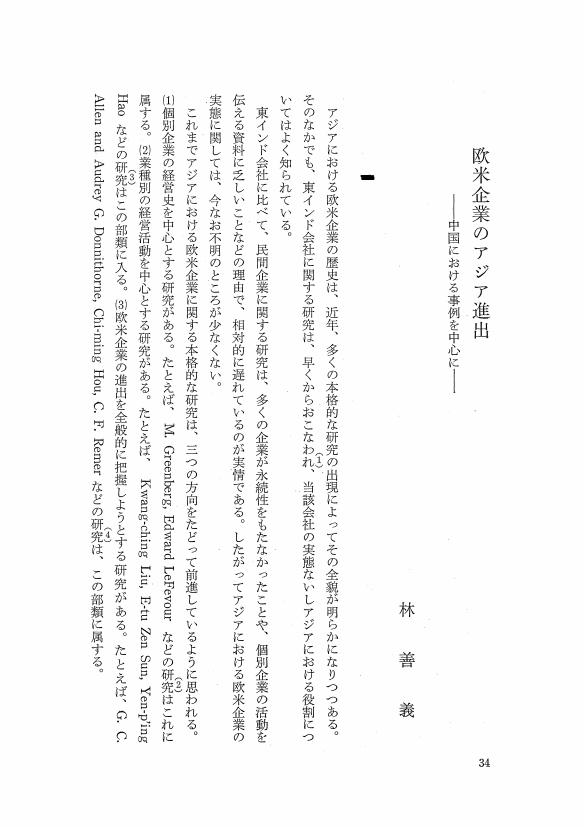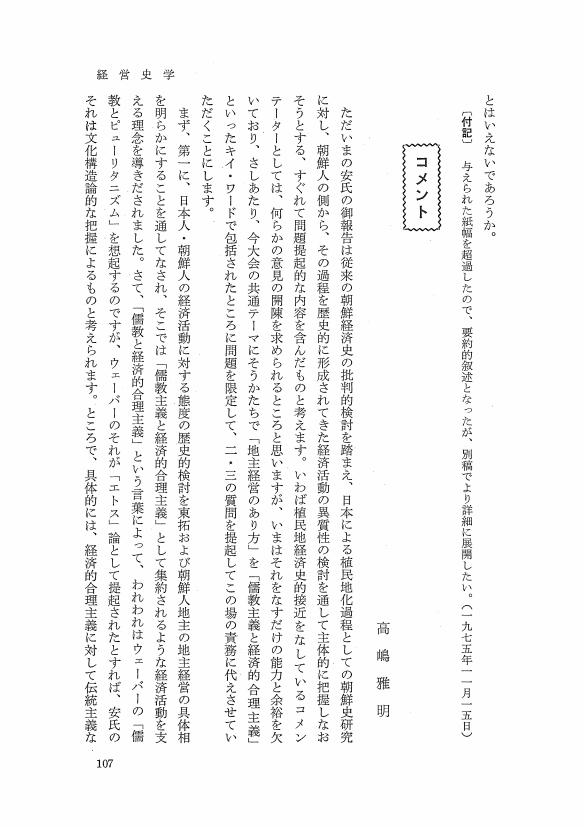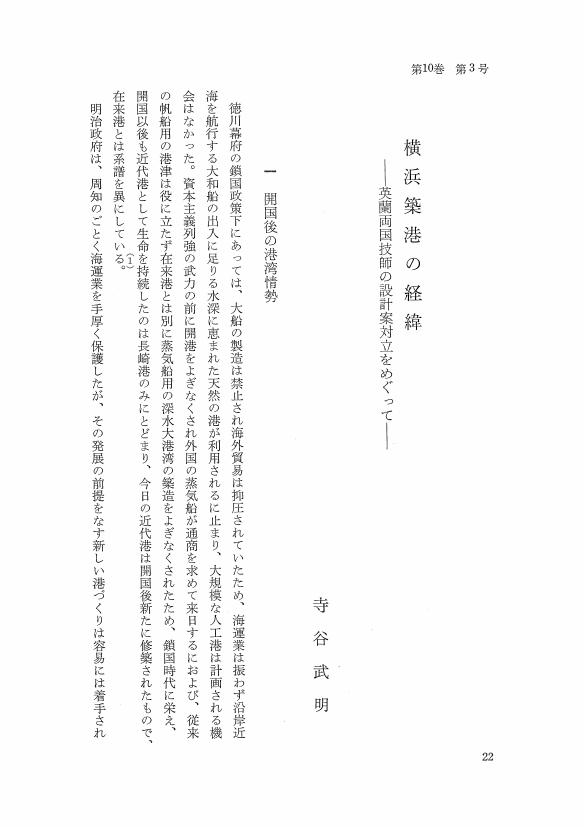1 0 0 0 OA 欧米企業のアジア進出 中国における事例を中心に
- 著者
- 林 善義
- 出版者
- 経営史学会
- 雑誌
- 経営史学 (ISSN:03869113)
- 巻号頁・発行日
- vol.11, no.1, pp.34-45, 1976-07-20 (Released:2009-11-06)
1 0 0 0 OA 日産財閥の満州進出
- 著者
- 宇田川 勝
- 出版者
- 経営史学会
- 雑誌
- 経営史学 (ISSN:03869113)
- 巻号頁・発行日
- vol.11, no.1, pp.46-72, 1976-07-20 (Released:2009-11-06)
1 0 0 0 OA コメント1
- 著者
- 衣笠 洋輔
- 出版者
- 経営史学会
- 雑誌
- 経営史学 (ISSN:03869113)
- 巻号頁・発行日
- vol.11, no.1, pp.72-74, 1976-07-20 (Released:2009-11-06)
1 0 0 0 OA コメント2
- 著者
- 高嶋 雅明
- 出版者
- 経営史学会
- 雑誌
- 経営史学 (ISSN:03869113)
- 巻号頁・発行日
- vol.11, no.1, pp.107-109, 1976-07-20 (Released:2009-11-06)
1 0 0 0 OA 昭和初年の日・ソ漁業会社の労務管理の相互影響
- 著者
- 三島 康雄
- 出版者
- 経営史学会
- 雑誌
- 経営史学 (ISSN:03869113)
- 巻号頁・発行日
- vol.11, no.1, pp.110-131, 1976-07-20 (Released:2009-11-06)
1 0 0 0 OA コメント3
- 著者
- 吉原 英樹
- 出版者
- 経営史学会
- 雑誌
- 経営史学 (ISSN:03869113)
- 巻号頁・発行日
- vol.11, no.1, pp.131-133, 1976-07-20 (Released:2009-11-06)
1 0 0 0 OA パネル・ディスカッション
- 出版者
- 経営史学会
- 雑誌
- 経営史学 (ISSN:03869113)
- 巻号頁・発行日
- vol.11, no.1, pp.134-153, 1976-07-20 (Released:2009-11-06)
1 0 0 0 OA パネル・ディスカッション
- 出版者
- 経営史学会
- 雑誌
- 経営史学 (ISSN:03869113)
- 巻号頁・発行日
- vol.10, no.1, pp.107-120, 1975-08-25 (Released:2009-11-06)
1 0 0 0 OA ボルティモー商品流通史論 -一七八〇年~一七八七年を中心に-
- 著者
- 豊原 治郎
- 出版者
- 経営史学会
- 雑誌
- 経営史学 (ISSN:03869113)
- 巻号頁・発行日
- vol.10, no.2, pp.1-21,a1, 1975-10-10 (Released:2009-11-06)
This article is in a series of my projected researches regarding the American-Canadian commercial-business history from the latter half of the 18th century to the first half of the 19th century.This paper consists of three facets: a general description of the socio-economic development of Baltimore during the latter half of the 18th century; a brief analysis of some commercial-business-historical characteristics of Baltimore's maritime industry and her foreign-coastwise trades; and lastly some considerations of the entrepreneurial activities of Robert Oliver, “the commission merchant-importer-exporter, typically a stay-at-home-merchant” in Baltimore during the eighties. In onther words, this article becomes one of my works based upon economic-business-historical approaches.In making this paper, I had a lot of valuable opportunities to read through some original data in Washington National Archives.
1 0 0 0 OA 一九世紀末葉のアメリカ兵器工業 -直系管理組織の無機能化とテイラー・システム-
- 著者
- 塩見 治人
- 出版者
- 経営史学会
- 雑誌
- 経営史学 (ISSN:03869113)
- 巻号頁・発行日
- vol.10, no.2, pp.22-48,2, 1975-10-10 (Released:2009-11-06)
The aim of this paper is to investigate the historical function of the Taylor system in the American arms industry. For this purpose, I treat firstly, what was the main problem of management in the arms industry in the late 19th century, and secondly, what role did the Taylor system have in this sector.The Taylor system of management was first brought into the arms industry at the Watertown Arsenal in 1909, followed by the New Heaven Plant of the Winchester Repeating Arms Co. in 1915. Till the introduction of the Taylor system, the New Heaven Plant adopted the line production method, while at the Watertown Arsenal, layout of the production line was so confused that they did not even bring machinery of the same type into the same section of the shop. Both of these plants, however, were managed by the similar traditional simple line organization. In both cases, such a management organization resulted in the functional disorder of management before the end of the 19th century.The Taylor system, being introduced into the two plants for the purpose of reform, by separating the management function from operation and subdividing it into specialized functions, created the base of the modern line and staff organization in the arms industry.
1 0 0 0 OA 形成期ビジネス・スクールにおける管理論
- 著者
- 斎藤 毅憲
- 出版者
- 経営史学会
- 雑誌
- 経営史学 (ISSN:03869113)
- 巻号頁・発行日
- vol.10, no.2, pp.49-77,3, 1975-10-10 (Released:2009-11-06)
In this paper I tried to investigate into an aspect of the American management movement up to the 1920s, from a viewpoint of the development of collegiate business education. Accordingly, the rise of business management could be treated so far as it became to be a subject of business education.A concrete study I make first is how management was introduced into the curriculum in the first half of the 1910s. The second point is the fact that the management was not regarded to be the most important subject in business school in the 1920s, in spite of its increasing and diverse advancement in the business world.
1 0 0 0 OA 一九世紀後期イギリス造船業における労使関係
- 著者
- 荒井 政治
- 出版者
- 経営史学会
- 雑誌
- 経営史学 (ISSN:03869113)
- 巻号頁・発行日
- vol.10, no.3, pp.1-21, 1975-03-20 (Released:2009-11-06)
1 0 0 0 OA 横浜築港の経緯 英蘭両国技師の設計案対立をめぐって
- 著者
- 寺谷 武明
- 出版者
- 経営史学会
- 雑誌
- 経営史学 (ISSN:03869113)
- 巻号頁・発行日
- vol.10, no.3, pp.22-41, 1975-03-20 (Released:2009-11-06)
1 0 0 0 OA 明治中期大正期における王子製紙と富士製紙 寡占的な発展をもたらした経営戦略を中心に
- 著者
- 四宮 俊之
- 出版者
- 経営史学会
- 雑誌
- 経営史学 (ISSN:03869113)
- 巻号頁・発行日
- vol.10, no.3, pp.42-62, 1975-03-20 (Released:2009-11-06)
1 0 0 0 OA 問題提起-文化構造と企業者活動
- 著者
- 中川 敬一郎
- 出版者
- 経営史学会
- 雑誌
- 経営史学 (ISSN:03869113)
- 巻号頁・発行日
- vol.10, no.1, pp.1-4, 1975-08-25 (Released:2009-11-06)
1 0 0 0 OA 文化と企業者活動についての諸理論の検討 M・ウェーバー以後の理論的展開
- 著者
- 間 宏
- 出版者
- 経営史学会
- 雑誌
- 経営史学 (ISSN:03869113)
- 巻号頁・発行日
- vol.10, no.1, pp.5-28, 1975-08-25 (Released:2009-11-06)
The tenth annual meeting of the Business History Society of Japan was held at the University of Tokyo on the 5 th and 6 th of October 1974. On the first day we had a free-topic session as usual and twelve papers were reported. All of the five papers in this special issue were read at the common-topic session on the second day of the meeting.In the opening address, professor Keiichiro Nakagawa of the University of Tokyo, who was one of the organizers of the latter session, emphasized the significance of the study on “Cultural Structure and Entrepreneurship” for us, Japanese business historians. Professor Nakagawa stated that after the Vietnam War American business historians have lost interest in this kind of study, but, he continued, we should actively continue to pursue it.Professor Hiroshi Hazama of Tokyo Kyoiku University explained some sociological and psychological approaches to the relationship between entrepreneurship and cultural factors, specifically entrepreneurial or managerial ideologies and cultural values, following Max Weber's thesis. He also examined the applicability of these approaches, which were arguments founded on facts of Western societies, to the Japanese society.Professor Johannes Hirschmeier of Nanzan University and professor Tsunehiko Yui of Meiji University clarified the relationship between the traditional value system and businesses in the process of industrialization in Japan. Professor Yui expressed a noteworthy hypothesis on the traditional value system in the Tokugawa era and referred to impacts of the system on business activities after the Meiji era. Professor Hirschmeier explained the characteristics of the “spirit of capitalism” in Japan compared with that in Western countries.Professor Kazuo Sugiyama of Seikei University presented the result of his close investigation concerning financial and investment behaviors of cotton-spinning and railway companies in the Meiji era. These behaviors were considered not separately but as a complete process from the decision-making on investment by top management to the setting of equipments they are related to different stages of development of companies and to their cultural background.The final speaker, professor Shigeaki Yasuoka of Doshisha University, pointed out the conditions of business control of the Zaibatu by monopolistic ownership before World War II in Japan with historical and cultural views. He especially made clear the reason why the Zaibatu, which had grown up in the Tokugawa era or in early Meiji, limited the investors of their head companies to their families and why they could control many modern companies though they had kept premodern traits.The panel discussion on the common topic was presided by professor Kin-ichiro Toba of Waseda University and professor Hidemasa Morikawa of Hosei University.
1 0 0 0 OA コメント1
1 0 0 0 OA コメント2
- 著者
- 小林 袈裟治
- 出版者
- 経営史学会
- 雑誌
- 経営史学 (ISSN:03869113)
- 巻号頁・発行日
- vol.10, no.1, pp.51-53, 1975-08-25 (Released:2009-11-06)
1 0 0 0 OA 企業の財務・投資活動と文化的背景 明治期の鉄道業・綿紡績業を事例として
- 著者
- 杉山 和雄
- 出版者
- 経営史学会
- 雑誌
- 経営史学 (ISSN:03869113)
- 巻号頁・発行日
- vol.10, no.1, pp.54-86, 1975-08-25 (Released:2009-11-06)
1 0 0 0 OA 財閥形成の文化的・社会的背景
- 著者
- 安岡 重明
- 出版者
- 経営史学会
- 雑誌
- 経営史学 (ISSN:03869113)
- 巻号頁・発行日
- vol.10, no.1, pp.87-101, 1975-08-25 (Released:2009-11-06)















